
“Private RENDEZVOUS WITH BAIKAL SEALS”
on cruise and wildlife viewing tour combined with BAM railway ride
Lake Baikal - "Mother Baikal" to Russia's ancient Buddhist peoples, "Pearl of Siberia" to others who live near her - is well known, both as sacred symbol and natural gem. Four thousand times older than North America's Great Lakes, Baikal holds 22% of the world's available fresh water. If Baikal was empty and all of the planet's major rivers drained into her - the Nile, Amazon, Mississippi, Danube, and numerous others combined - it would take over a year for the lake to be filled.
Lake Baikal is home to the world's only fresh water seal – locally called “the nerpa”. Believed to have descended from the Arctic Ocean over 800,000 years ago, the nerpa has since claimed Lake Baikal as its own. With no natural predators other than humans, the seals are precious living symbols of the lake's uniqueness.
We invite you on an exciting wildlife sailing trip on Lake Baikal in the premises of Baikal nature reserves, take pictures of the breathtaking views, and be introduced to ancient traditions of shamanist believers and much more….
On the trip below one of local well-known photographer-biologists will join us to tell some hints and peculiarities of picture taking of Baikal wildlife. He’ll be shooting with us 3 days, and each evening he stays with us we’ll talk about the next day shooting and dwell on shooting strategies for making the most of that, as well as review our shooting each of the days, discuss what worked and what didn’t. We can not guarantee that you’ll get world class images, but we will work hard to make sure you have the best possible chance!
Besides the wildlife viewing the tour below highlights the famous Soviet railway engineering feast and offer riding BAM railway on the way from north of Baikal back to Irkutsk…
The Itinerary Description
Day 1
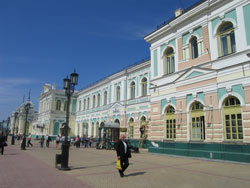 We arrive early in the morning in Irkutsk and are transferred to the EMPIRE Hotel, which is located in the very downtown of Irkutsk near the Angara river embankment. After having settled in, we will depart for an interesting tour of the city. During the tour we will visit the city’s historical center and its most visually attracted sights, including the Znamenskaya Orthodox Cathedral, noted for its historical grave of the so-called “Russian Columbus” Grigory Shelekhov who was an early Russian explorer of Alaska. We also observe the graves of the Decembrists-revolutionaries who were banned to Siberia after an ill-fated attempt in 1825 to overthrow the Russian tsar, and have the opportunity to take pictures of the richly carved old-style wooden houses, see the Monument to Russian Pioneers of Siberia topped by the bronze figure of Alexander-the 3rd and the White House fo the Siberian province as we as the central market. Lunch will be on the way. Dinner and overnight back at your hotel. We arrive early in the morning in Irkutsk and are transferred to the EMPIRE Hotel, which is located in the very downtown of Irkutsk near the Angara river embankment. After having settled in, we will depart for an interesting tour of the city. During the tour we will visit the city’s historical center and its most visually attracted sights, including the Znamenskaya Orthodox Cathedral, noted for its historical grave of the so-called “Russian Columbus” Grigory Shelekhov who was an early Russian explorer of Alaska. We also observe the graves of the Decembrists-revolutionaries who were banned to Siberia after an ill-fated attempt in 1825 to overthrow the Russian tsar, and have the opportunity to take pictures of the richly carved old-style wooden houses, see the Monument to Russian Pioneers of Siberia topped by the bronze figure of Alexander-the 3rd and the White House fo the Siberian province as we as the central market. Lunch will be on the way. Dinner and overnight back at your hotel.
Day 2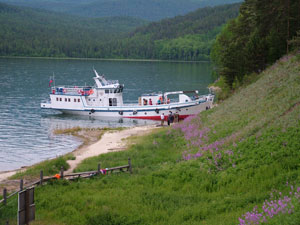
After breakfast we check out from the hotel for departure by coach from Irkutsk to the Listvyanka settlement, located on Lake Baikal in the mouth of the Angara river ( the lake’s only outlet). En route we stop near the Shaman Rock in the mouth of the Angara for a short stop to hear the guide’s story and legend about “strict father Baikal and his disobedient daughter Angara” as well as for taking pictures. Then we visit the Baikal Ecology Museum which has one-of-a-kind collection of exhibits about flora and fauna of Baikal, see recently constructed Aquarium with Baikal fresh water seals. Afterwards we drive to the boat station to board our vessel, home for the next seven days. When boarding the vessel enjoy “One for the Road” Captain’s Welcome Drink and have the captain introduce the crew to you.
Around 12:30 we start out on our circumnavigation of Lake Baikal. We shall be served lunch on board while on the way to the Peschanaya ( meaning “Sandy”) Bay ( 80 km, 5.5 hour boat ride) , often referred to as the Siberian Riviera due to the great number of sunshine observed here ( mid annual temperature here is positive - +0.4 Celcius) . Upon arrival in Peschanaya Bay we enjoy a guided walk to the Babushka Bay, the Small Bell tower Craig to take pictures of panoramic evening views on the taiga-woods of the Cedar Pass and other natural settings ( in particular here you will observe one of the lake’s natural wonders – the so-called “Wandering Trees”). Dinner will feature some of the famous Baikal specialties served back on board. Overnight on board.
Day 3
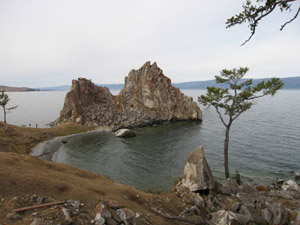 Breakfast shall be served on board while we continue further along our cruise to the Khuzhir settlement on Olkhon Island (the biggest and only permanently inhabited Island on the lake). En route stop to see famous Tsagan Zaba White Marble Cliffs and observe the rock drawings\ petrogliphs, more than 2500 years old which depict the scenes from the lives of shamanistic believers. These petrogliphs were called by a famous Russian anthropologist Okladnikov “the Pearls of ancient art.” We shall disembark here to get close to the rock drawings and to be able to take pictures. After lunch on board we reach Olkhon Island and enjoy its stunning scenery. Although the island is quite narrow, half of it lengthways is forest and the other half steppe. Our boat will take us to the so-called Small Sea which is the part of Lake Baikal enclosed by the mainland shore and the island’s eastern shore. Before we reach the central settlement of Khuzhir on the island we will come to the small island of Ogoy – the place of the only Buddhist stupa placed on the lake. The height of the Stupa is over 10 meters and inside the stupa there are 2.5 tons of Buddhist mantras and 700 kilograms of holy Buddhist books that were specially brought from Nepal. The Ogoy stupa place recently became the holy place of Buddhist pilgrimage. Breakfast shall be served on board while we continue further along our cruise to the Khuzhir settlement on Olkhon Island (the biggest and only permanently inhabited Island on the lake). En route stop to see famous Tsagan Zaba White Marble Cliffs and observe the rock drawings\ petrogliphs, more than 2500 years old which depict the scenes from the lives of shamanistic believers. These petrogliphs were called by a famous Russian anthropologist Okladnikov “the Pearls of ancient art.” We shall disembark here to get close to the rock drawings and to be able to take pictures. After lunch on board we reach Olkhon Island and enjoy its stunning scenery. Although the island is quite narrow, half of it lengthways is forest and the other half steppe. Our boat will take us to the so-called Small Sea which is the part of Lake Baikal enclosed by the mainland shore and the island’s eastern shore. Before we reach the central settlement of Khuzhir on the island we will come to the small island of Ogoy – the place of the only Buddhist stupa placed on the lake. The height of the Stupa is over 10 meters and inside the stupa there are 2.5 tons of Buddhist mantras and 700 kilograms of holy Buddhist books that were specially brought from Nepal. The Ogoy stupa place recently became the holy place of Buddhist pilgrimage.
Later in the evening we shall reach by boat Khuzhir settlement featuring another holy place of Lake Baikal - the famous Shamanka Craig which we walk to through Khuzhir village. The Shaman Craig well-known for the so-called “Buddha Rock of Altar” is one of Holy of Hollies of shamanists and Buddhist alike. Long ago, locals covered their horses' hooves when passing so as not to disturb the spirits living there. Now you can scramble up the cliffs or sit on the beach below, gazing at the mountains across the water.
Here we shall be met by the local famous practicing “White Shaman” – and Oot Kha, a hereditary shaman. He will perform the rite of purification for you and involve you in the ritual of offerings to the deities of lake Baikal and the Island’s major spirits. After the ceremony we’ll have a discussion on the Shamanism of Siberia, its philosophy and outlook. Then – enjoy a Siberian Banya (steam sauna). Dinner shall be served on board to be followed by the Baikal Songs Lesson # 1.
 Olkhon Island. Mid-way on the northern shore of Baikal is an area considered to be the most sacred. It is here, about eight miles from the north shore that we find Olkhon, named by the Buryats for the forests which cover the island. Olkhon is the biggest island on Baikal extending more than 70 km. (60 miles) in length and up to 20 km. (15 miles) in width. Its terrain is varied with sweeping prairies, steep rocks, dry valleys overgrown with berry bushes and small, shallow bays with sandy beaches and warm water. The island's steep sides cut into the aquamarine sea-lake and its capes are like characters out of ancient Siberian folk-tales guarding the island's peace. The most beautiful of these capes, Burchan, bears the name of the Buryats' primary god. The bank closest to Burchan has a cave which cuts through the rock. The entrance is on the eastern side and the exit on the western one. Native people considered the cave a sacred place, a dwelling of shamans. The cave is, however, now inscribed with Buddhist prayers, remnants of seventeenth century arrival of Tibetan Lamaist Buddhism. The new religion partly absorbed the native shamanistic traditions and partially replaced them. The first words of one prayer read, "Ou, Burchan, Tingiri!", invoking the Buryat-Lamaist's god and heaven. Olkhon Island. Mid-way on the northern shore of Baikal is an area considered to be the most sacred. It is here, about eight miles from the north shore that we find Olkhon, named by the Buryats for the forests which cover the island. Olkhon is the biggest island on Baikal extending more than 70 km. (60 miles) in length and up to 20 km. (15 miles) in width. Its terrain is varied with sweeping prairies, steep rocks, dry valleys overgrown with berry bushes and small, shallow bays with sandy beaches and warm water. The island's steep sides cut into the aquamarine sea-lake and its capes are like characters out of ancient Siberian folk-tales guarding the island's peace. The most beautiful of these capes, Burchan, bears the name of the Buryats' primary god. The bank closest to Burchan has a cave which cuts through the rock. The entrance is on the eastern side and the exit on the western one. Native people considered the cave a sacred place, a dwelling of shamans. The cave is, however, now inscribed with Buddhist prayers, remnants of seventeenth century arrival of Tibetan Lamaist Buddhism. The new religion partly absorbed the native shamanistic traditions and partially replaced them. The first words of one prayer read, "Ou, Burchan, Tingiri!", invoking the Buryat-Lamaist's god and heaven. |
Day 4 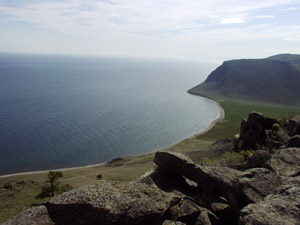
After breakfast we shall visit a small but very interesting museum in Khuzhir settlement that has some unique items on display including so-called Chinghiz plate. Then we undertake a short walk to a local family to have lunch and chat at the “samovar”. After the tour of the fishing village of Khuzhir we get back on our boat to continue further along the western shore of the Island to the mysterious cape of Rytiy associated with many shamanistic legends and which geological composition is quite a unique one. En route we shall make our last stop on Olkhon Island –near the abandoned village of Peschanaya, or Sandy. The village was built around a small fishery that used forced labors from the Island’s only GULAG camp that was built during Stalin’s purges in 1933 and closed in 1950. Here besides just seeing the remains of Baikal Gulag we can take good pictures of Baikal flowers that grow right in the sand nearby the shore.
We shall stop for the overnight on our boat in one of the picturesque bays of Lake Baikal where we will have a fish-barbecue prepared in a special Baikal way.
Overnight on board.
Day 5
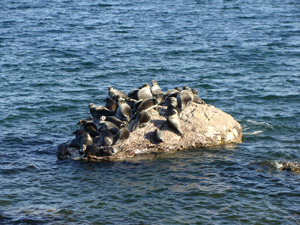 After breakfast we will be approaching the biggest rookery of Baikal fresh water seals - Ushkanyi Island or The Ushkaniye Archipelago –which consists of four islands: Tonky, Bolshoye Ushkaniye, Koltigey and Lokhnaty. It is believed by geologists that these four islands hold the key to unlocking the geological secrets behind the formation of Lake Baikal. Since the islands appeared they have risen at a rate o f 2 meters every 1,000 of years, giving scientists reasons to believe that in the future they may become one island. After breakfast we will be approaching the biggest rookery of Baikal fresh water seals - Ushkanyi Island or The Ushkaniye Archipelago –which consists of four islands: Tonky, Bolshoye Ushkaniye, Koltigey and Lokhnaty. It is believed by geologists that these four islands hold the key to unlocking the geological secrets behind the formation of Lake Baikal. Since the islands appeared they have risen at a rate o f 2 meters every 1,000 of years, giving scientists reasons to believe that in the future they may become one island.
Here escorted by a local national park ranger we get off the boat and sneak to the Island’s flat underwater rocks where seals like to stay most of their time while they are near here. Hidden behind the camouflage nets we shall be able to watch and take pictures of the Baikal fresh water seals.
After seeing the seals we get back on the boat to continue another 50 km to the Zavorotnaya Bay on the western shore. We have dinner here. Then and after a brief lecture on know-how’s of local fishing techniques we go for the evening fishing to catch Baikal black grayling and, perhaps, omul-fish. Overnight on the boat.
 The mystery of how the Nerpa – Baikal fresh water seal - came to Baikal still baffles scientists. Apart from being a The mystery of how the Nerpa – Baikal fresh water seal - came to Baikal still baffles scientists. Apart from being a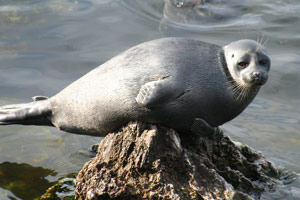 freshwater reservoir, Lake Baikal is hundreds of miles from any other sea or ocean. Most believe that thousands of years ago, the salt water of the Arctic Ocean stretched into the lower reaches of the Yenisey up to the mouth of the Angara. Many scientists agree that the seal belongs to the Tertiary fauna, and most likely migrated to the region during the early stages of the period when the Baikal Depression formed. It is thought that in search for food, the seals gradually migrated deeper into the mainland. There have been years when scientists have counted nearly one hundred thousand nerpa in and around the lake. Valued for their soft, warm pelts and fat, the seals have been hunted for thousands of years. For centuries ethnic Buryat people living around the lake have hunted seals, venturing out on the treacherous ice in the spring just after the pups, known as “kumutkans”, were born. It is a tradition that has been passed from father to son. The meat was eaten or preserved for the long winters ahead. Skins were used to cover canoes and the fur for clothing. Nothing was wasted, and the catch was small enough that the seal population was not threatened… freshwater reservoir, Lake Baikal is hundreds of miles from any other sea or ocean. Most believe that thousands of years ago, the salt water of the Arctic Ocean stretched into the lower reaches of the Yenisey up to the mouth of the Angara. Many scientists agree that the seal belongs to the Tertiary fauna, and most likely migrated to the region during the early stages of the period when the Baikal Depression formed. It is thought that in search for food, the seals gradually migrated deeper into the mainland. There have been years when scientists have counted nearly one hundred thousand nerpa in and around the lake. Valued for their soft, warm pelts and fat, the seals have been hunted for thousands of years. For centuries ethnic Buryat people living around the lake have hunted seals, venturing out on the treacherous ice in the spring just after the pups, known as “kumutkans”, were born. It is a tradition that has been passed from father to son. The meat was eaten or preserved for the long winters ahead. Skins were used to cover canoes and the fur for clothing. Nothing was wasted, and the catch was small enough that the seal population was not threatened… |
Day 6
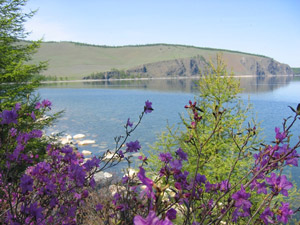 After breakfast we’ll be already approaching the so-called “Coast of Brown Bears” in the premises of Baikalo-Lensky Nature Reserve . Founded in 1986 to maintain the intact nature at the western shore in the Baikals’ki-Mountains the Baikalo-Lensky strictly protected area makes up 659,000 ha and forms the largest part of the nature preserve in the Lake Baikal region. The great Siberian Lena river originates in this area giving the reserve its name. Here, in summer time one can observe the brown bears that come out from the taiga-woods and are often seen on the Baikal shore. In early summer brown bears come to the lakeshore to feed on the Baikal endemic caddisflies (Trichoptera, Limnephilidae) (Baikal sedge). On Lake Baikal, the endemic caddis flies are famous for their mass abundances on emergence after ice-break-up in June. Freshly emerged species of Baikal caddis flies can form up to 15 cm thick living carpets and these slow moving insects penetrate any natural surface or opening, structures (such as trees) rising from near the lake or boat vessels. That’s why when we stop at this time near the shore, be ready to find these non-biting insects anywhere on the vessel and even in some of your clothes. The local caddis peculiarity is that they come to the shore after laying their eggs in order soon to die at the beach. For Baikal brown bears the caddis flies are their early summer delicacy: bears appreciate this additional protein source and visit the beach likewise. After breakfast we’ll be already approaching the so-called “Coast of Brown Bears” in the premises of Baikalo-Lensky Nature Reserve . Founded in 1986 to maintain the intact nature at the western shore in the Baikals’ki-Mountains the Baikalo-Lensky strictly protected area makes up 659,000 ha and forms the largest part of the nature preserve in the Lake Baikal region. The great Siberian Lena river originates in this area giving the reserve its name. Here, in summer time one can observe the brown bears that come out from the taiga-woods and are often seen on the Baikal shore. In early summer brown bears come to the lakeshore to feed on the Baikal endemic caddisflies (Trichoptera, Limnephilidae) (Baikal sedge). On Lake Baikal, the endemic caddis flies are famous for their mass abundances on emergence after ice-break-up in June. Freshly emerged species of Baikal caddis flies can form up to 15 cm thick living carpets and these slow moving insects penetrate any natural surface or opening, structures (such as trees) rising from near the lake or boat vessels. That’s why when we stop at this time near the shore, be ready to find these non-biting insects anywhere on the vessel and even in some of your clothes. The local caddis peculiarity is that they come to the shore after laying their eggs in order soon to die at the beach. For Baikal brown bears the caddis flies are their early summer delicacy: bears appreciate this additional protein source and visit the beach likewise.
If we come to Baikal-Lensky Reserve area after the Baikal caddis flies are gone, then in order to provide nice opportunities for watching the brown bears , local rangers on prior agreement with us and a week before our expected arrival will lay special bait to lure the beast to the site. Once the Baikal brown bear is attracted by the bait, it will always return to it until the bait is over.
To ensure we have plenty of opportunities to see and watch brown bears, upon entering the premises of the Baikal-Lensky nature reserve the local ranger-biologists well-familiar with the bear habits in the territory will join us no board of our vessel and lead en route the Coast of Brown Bears.
Beside brown bears at Baikal Lensky nature reserve one can often see such animals as elk and musk deer on mountain slopes, sable, wolf, lynx and fox in the mountain valleys adjacent to the Baikal shore.
Finally, this day we shall cover by boat over 90 km. Following the shore that is covered by the Great Baikal Trail we eventually reach the Cape of Kotelnikovsky famed for the thermal springs and beautiful scenery. Here we stop in a picturesque bay for a night. Before dinner or even after it we will have time to explore the surroundings of the Kotelnikovsky Cape – the site of the hottest mineral springs on Lake Baikal and the only warm one on its western shore. The springs come out right on the lake’s shore , and there’re plenty of opportunities to make one’s own mineral bath in the shore pebble stones …as well as take nice photos of natural landscapes with Pick of Tchersky ( the highest mountain of the Baikal mountain range,2588 m) in the far back ground.
|
 Baikalo-Lensky Reserve includes parts of Lake Baikal shoreline, mountain landscapes and the Lena River source with different natural conditions and geological structure. Up from Baikal's shore, mountains rise sharply for a vertical mile,down from the shoreline descends another mile-deep rift, almost 400 miles long, that holds one-fifth the fresh water of all the world's lakes. And beneath Baikal's lake floor lie at least four vertical miles of silt, deposited by hundreds of tributaries during 16 million years. While other lakes filled with sediment and disappeared, Baikal survived, growing wider and deeper where Asia splits at tectonic seams, permitting the evolution of hundreds of endemic species. The mountain tundras with high mountain meadows are successed with krummholz thickets of cedar pine woodlands. In the lower belt light coniferous taiga is construed of pine and larch, with the poplar and Chosenia growing in the valleys. Cedar, fir, larch and spruce prevail in the tree flora on the western slopes of the Baikalsky mountain range and in the lower dark coniferous forests that support rich birdlife. About 260 bird species have been recorded in the reserve territory, including about 150 breeding ones. On the Baikal-lake common species are White-winged Scoter, Shoveler, Gadwall, Falcated Duck and Ruddy Shelduck, osprey, golden eagle, peregrine falcon, Chinese scrub warbler and Eastern solitary snipe, sometimes Baikal teals are encountered. In the different kinds of waterside habitats breed waders, such as Common Sandpiper, Wood Sandpiper, Pin-tailed Snipe & Common Snipe – and even Asiatic dowitcher. The forests are full of owls such as Long-eared Owl, Marsh Owl & Tengmalm’s Owl, and wood grouse, Rock Dove and partridge, three Swift species: Siberian, Black & Needle-tailed; and Hoopoe. Areas of scrub are bird rich with species such as Yellow-breasted Bunting and Chestnut Bunting. Lower mountain slopes hold a great number of Thrushes, Pallas’s Grasshopper Warbler, Siberian Ruby-throat, Siberian Blue Robin & Daurian Jackdaw. The avifauna of the high mountains is more special: it is the only place to find Red-bellied Redstart, Polar Bunting, Water Pipit & Brown Accentor. Such interesting birds as white-tailed eagle, Isabelline Wheatear, Pied Wheatear, Rock Thrush and Meadow Bunting live in the steppe areas on the lake banks. Baikalo-Lensky Reserve includes parts of Lake Baikal shoreline, mountain landscapes and the Lena River source with different natural conditions and geological structure. Up from Baikal's shore, mountains rise sharply for a vertical mile,down from the shoreline descends another mile-deep rift, almost 400 miles long, that holds one-fifth the fresh water of all the world's lakes. And beneath Baikal's lake floor lie at least four vertical miles of silt, deposited by hundreds of tributaries during 16 million years. While other lakes filled with sediment and disappeared, Baikal survived, growing wider and deeper where Asia splits at tectonic seams, permitting the evolution of hundreds of endemic species. The mountain tundras with high mountain meadows are successed with krummholz thickets of cedar pine woodlands. In the lower belt light coniferous taiga is construed of pine and larch, with the poplar and Chosenia growing in the valleys. Cedar, fir, larch and spruce prevail in the tree flora on the western slopes of the Baikalsky mountain range and in the lower dark coniferous forests that support rich birdlife. About 260 bird species have been recorded in the reserve territory, including about 150 breeding ones. On the Baikal-lake common species are White-winged Scoter, Shoveler, Gadwall, Falcated Duck and Ruddy Shelduck, osprey, golden eagle, peregrine falcon, Chinese scrub warbler and Eastern solitary snipe, sometimes Baikal teals are encountered. In the different kinds of waterside habitats breed waders, such as Common Sandpiper, Wood Sandpiper, Pin-tailed Snipe & Common Snipe – and even Asiatic dowitcher. The forests are full of owls such as Long-eared Owl, Marsh Owl & Tengmalm’s Owl, and wood grouse, Rock Dove and partridge, three Swift species: Siberian, Black & Needle-tailed; and Hoopoe. Areas of scrub are bird rich with species such as Yellow-breasted Bunting and Chestnut Bunting. Lower mountain slopes hold a great number of Thrushes, Pallas’s Grasshopper Warbler, Siberian Ruby-throat, Siberian Blue Robin & Daurian Jackdaw. The avifauna of the high mountains is more special: it is the only place to find Red-bellied Redstart, Polar Bunting, Water Pipit & Brown Accentor. Such interesting birds as white-tailed eagle, Isabelline Wheatear, Pied Wheatear, Rock Thrush and Meadow Bunting live in the steppe areas on the lake banks.
|
Day 7
After breakfast we continue northwards to the town of Severobaikalsk which we reach by the lunch time. After lunch we check out from the boat and drive to tour the town. We shall have a guided tour the Museum of BAM-construction (Baikal-Amur Railway). After a short walk to explore the down town of Severobaikalsk we will have dinner at the local “Russ’” pub famous for its own brewery – here the Baikal northernmost beer is made. After dinner – transfer to the railway station to board the train to Irkutsk.
At 10:35 p.m – departure by train to Irkutsk with overnight on the train.
(Total train riding time from Severobaikalsk to Irkutsk is 32 and a half hours. The train is operated on each uneven date)
Day 8
Full-day trip on along the rails of famous BAM railroad – the feast of the Soveit railway engeneering passing by stations of Kunerma, Ulkan, Lena, Ust-Kut, Bratsk, Chuna, Taishet and Zima on the way to Irkutsk while your informative guide will tell you many interesting and fabulous facts about the places you go by. Breakfast, lunch, dinner and overnight on the train.
Day 9
07:06 – Upon morning arrival in Irkutsk we meet you and assist at the railway station. Transfer to your hotel for check in. After relaxing and lunch we will drive to see the Baikal seal training center. Before dinner you will still have some more time to explore the historical down town of Irkutsk. Overnight at the hotel.
Day 10
After early breaksfat tnarsfer to the airport to board the plane for flight #______(TBA)
 The Baikal Amur Mainline (Russian Baikal Amur Magistral, BAM) is a railway line in Russia. Traversing Eastern Siberia and the Russian Far East, the 4,234 km (2,305 m.) long BAM runs about 380 to 480 miles north of and parallel with the Trans-Siberian railway. The route of the present-day BAM was first considered in the 1880s as an option for the eastern section of the Trans-Siberian railway. BAM departs from the Trans-Siberian railway at Taishet (Tayshet), then crosses Angara at Bratsk, crosses Lena, proceeds past Severobaikalsk on the northern tip of Lake Baikal, past Tynda and Khani, crosses the Amur River at Komsomolsk-na-Amure and finally reaches the Pacific Ocean at Sovetskaya Gavan. BAM was built as a strategic alternative route to the Trans-Siberian Railway, especially to the vulnerable sections which are close to the border with China. The section from Tayshet to Bratsk was built in the 1930s. Most of the Eastern section was built during the years 1944-1946, mainly by the gulag prisoners, including German and Japanese prisoners of war, of whom possibly as many as 150,000 died. In 1953, following Stalin's death, virtually all construction work on the BAM stopped and the line was abandoned to the elements for more than twenty years. In March 1974, Soviet General Secretary Leonid Brezhnev stated that a new BAM project would become a huge Komsomol undertaking. In September 1984, a "golden spike", akin to one used in Utah in 1867, was hammered into place, connecting the eastern and western sections of the BAM. No Western media were invited to attend this historic event as Soviet officials did not want any questions asked about the line's operational status and working conditions of the construction workers. In reality, only one third of the BAM's track was fully operational at the time of opening, and the forced labor was still widely used. BAM was finally declared complete in 1991. (from Wikipedia Free Encyclopedia) The Baikal Amur Mainline (Russian Baikal Amur Magistral, BAM) is a railway line in Russia. Traversing Eastern Siberia and the Russian Far East, the 4,234 km (2,305 m.) long BAM runs about 380 to 480 miles north of and parallel with the Trans-Siberian railway. The route of the present-day BAM was first considered in the 1880s as an option for the eastern section of the Trans-Siberian railway. BAM departs from the Trans-Siberian railway at Taishet (Tayshet), then crosses Angara at Bratsk, crosses Lena, proceeds past Severobaikalsk on the northern tip of Lake Baikal, past Tynda and Khani, crosses the Amur River at Komsomolsk-na-Amure and finally reaches the Pacific Ocean at Sovetskaya Gavan. BAM was built as a strategic alternative route to the Trans-Siberian Railway, especially to the vulnerable sections which are close to the border with China. The section from Tayshet to Bratsk was built in the 1930s. Most of the Eastern section was built during the years 1944-1946, mainly by the gulag prisoners, including German and Japanese prisoners of war, of whom possibly as many as 150,000 died. In 1953, following Stalin's death, virtually all construction work on the BAM stopped and the line was abandoned to the elements for more than twenty years. In March 1974, Soviet General Secretary Leonid Brezhnev stated that a new BAM project would become a huge Komsomol undertaking. In September 1984, a "golden spike", akin to one used in Utah in 1867, was hammered into place, connecting the eastern and western sections of the BAM. No Western media were invited to attend this historic event as Soviet officials did not want any questions asked about the line's operational status and working conditions of the construction workers. In reality, only one third of the BAM's track was fully operational at the time of opening, and the forced labor was still widely used. BAM was finally declared complete in 1991. (from Wikipedia Free Encyclopedia) |
Departure dates in 2010 from Irkutsk : TBA
Notes:
The type of boat to be used during the cruise: ocean-type, Soviet made “Yaroslavets”, built in 2007, (length – 25 m, width- 4 m, cruise speed – 18 km an hour, 6 passenger cabins each to accommodate 2 persons on its lower and upper births; the boat has 2 toilets and a shower. On the upper deck there’s a spacious lounge; the boat has a jet-boat, rescue raft, life jackets for all, is equipped for safe all-weather navigation, fishing tackles available on board for the use of vacationers… |




 We arrive early in the morning in Irkutsk and are transferred to the EMPIRE Hotel, which is located in the very downtown of Irkutsk near the Angara river embankment. After having settled in, we will depart for an interesting tour of the city. During the tour we will visit the city’s historical center and its most visually attracted sights, including the Znamenskaya Orthodox Cathedral, noted for its historical grave of the so-called “Russian Columbus” Grigory Shelekhov who was an early Russian explorer of Alaska. We also observe the graves of the Decembrists-revolutionaries who were banned to Siberia after an ill-fated attempt in 1825 to overthrow the Russian tsar, and have the opportunity to take pictures of the richly carved old-style wooden houses, see the Monument to Russian Pioneers of Siberia topped by the bronze figure of Alexander-the 3rd and the White House fo the Siberian province as we as the central market. Lunch will be on the way. Dinner and overnight back at your hotel.
We arrive early in the morning in Irkutsk and are transferred to the EMPIRE Hotel, which is located in the very downtown of Irkutsk near the Angara river embankment. After having settled in, we will depart for an interesting tour of the city. During the tour we will visit the city’s historical center and its most visually attracted sights, including the Znamenskaya Orthodox Cathedral, noted for its historical grave of the so-called “Russian Columbus” Grigory Shelekhov who was an early Russian explorer of Alaska. We also observe the graves of the Decembrists-revolutionaries who were banned to Siberia after an ill-fated attempt in 1825 to overthrow the Russian tsar, and have the opportunity to take pictures of the richly carved old-style wooden houses, see the Monument to Russian Pioneers of Siberia topped by the bronze figure of Alexander-the 3rd and the White House fo the Siberian province as we as the central market. Lunch will be on the way. Dinner and overnight back at your hotel.
 Breakfast shall be served on board while we continue further along our cruise to the Khuzhir settlement on Olkhon Island (the biggest and only permanently inhabited Island on the lake). En route stop to see famous Tsagan Zaba White Marble Cliffs and observe the rock drawings\ petrogliphs, more than 2500 years old which depict the scenes from the lives of shamanistic believers. These petrogliphs were called by a famous Russian anthropologist Okladnikov “the Pearls of ancient art.” We shall disembark here to get close to the rock drawings and to be able to take pictures. After lunch on board we reach Olkhon Island and enjoy its stunning scenery. Although the island is quite narrow, half of it lengthways is forest and the other half steppe. Our boat will take us to the so-called Small Sea which is the part of Lake Baikal enclosed by the mainland shore and the island’s eastern shore. Before we reach the central settlement of Khuzhir on the island we will come to the small island of Ogoy – the place of the only Buddhist stupa placed on the lake. The height of the Stupa is over 10 meters and inside the stupa there are 2.5 tons of Buddhist mantras and 700 kilograms of holy Buddhist books that were specially brought from Nepal. The Ogoy stupa place recently became the holy place of Buddhist pilgrimage.
Breakfast shall be served on board while we continue further along our cruise to the Khuzhir settlement on Olkhon Island (the biggest and only permanently inhabited Island on the lake). En route stop to see famous Tsagan Zaba White Marble Cliffs and observe the rock drawings\ petrogliphs, more than 2500 years old which depict the scenes from the lives of shamanistic believers. These petrogliphs were called by a famous Russian anthropologist Okladnikov “the Pearls of ancient art.” We shall disembark here to get close to the rock drawings and to be able to take pictures. After lunch on board we reach Olkhon Island and enjoy its stunning scenery. Although the island is quite narrow, half of it lengthways is forest and the other half steppe. Our boat will take us to the so-called Small Sea which is the part of Lake Baikal enclosed by the mainland shore and the island’s eastern shore. Before we reach the central settlement of Khuzhir on the island we will come to the small island of Ogoy – the place of the only Buddhist stupa placed on the lake. The height of the Stupa is over 10 meters and inside the stupa there are 2.5 tons of Buddhist mantras and 700 kilograms of holy Buddhist books that were specially brought from Nepal. The Ogoy stupa place recently became the holy place of Buddhist pilgrimage. 
 After breakfast we will be approaching the biggest rookery of Baikal fresh water seals - Ushkanyi Island or The Ushkaniye Archipelago –which consists of four islands: Tonky, Bolshoye Ushkaniye, Koltigey and Lokhnaty. It is believed by geologists that these four islands hold the key to unlocking the geological secrets behind the formation of Lake Baikal. Since the islands appeared they have risen at a rate o f 2 meters every 1,000 of years, giving scientists reasons to believe that in the future they may become one island.
After breakfast we will be approaching the biggest rookery of Baikal fresh water seals - Ushkanyi Island or The Ushkaniye Archipelago –which consists of four islands: Tonky, Bolshoye Ushkaniye, Koltigey and Lokhnaty. It is believed by geologists that these four islands hold the key to unlocking the geological secrets behind the formation of Lake Baikal. Since the islands appeared they have risen at a rate o f 2 meters every 1,000 of years, giving scientists reasons to believe that in the future they may become one island.  freshwater reservoir, Lake Baikal is hundreds of miles from any other sea or ocean. Most believe that thousands of years ago, the salt water of the Arctic Ocean stretched into the lower reaches of the Yenisey up to the mouth of the Angara. Many scientists agree that the seal belongs to the Tertiary fauna, and most likely migrated to the region during the early stages of the period when the Baikal Depression formed. It is thought that in search for food, the seals gradually migrated deeper into the mainland. There have been years when scientists have counted nearly one hundred thousand nerpa in and around the lake. Valued for their soft, warm pelts and fat, the seals have been hunted for thousands of years. For centuries ethnic Buryat people living around the lake have hunted seals, venturing out on the treacherous ice in the spring just after the pups, known as “kumutkans”, were born. It is a tradition that has been passed from father to son. The meat was eaten or preserved for the long winters ahead. Skins were used to cover canoes and the fur for clothing. Nothing was wasted, and the catch was small enough that the seal population was not threatened…
freshwater reservoir, Lake Baikal is hundreds of miles from any other sea or ocean. Most believe that thousands of years ago, the salt water of the Arctic Ocean stretched into the lower reaches of the Yenisey up to the mouth of the Angara. Many scientists agree that the seal belongs to the Tertiary fauna, and most likely migrated to the region during the early stages of the period when the Baikal Depression formed. It is thought that in search for food, the seals gradually migrated deeper into the mainland. There have been years when scientists have counted nearly one hundred thousand nerpa in and around the lake. Valued for their soft, warm pelts and fat, the seals have been hunted for thousands of years. For centuries ethnic Buryat people living around the lake have hunted seals, venturing out on the treacherous ice in the spring just after the pups, known as “kumutkans”, were born. It is a tradition that has been passed from father to son. The meat was eaten or preserved for the long winters ahead. Skins were used to cover canoes and the fur for clothing. Nothing was wasted, and the catch was small enough that the seal population was not threatened… After breakfast we’ll be already approaching the so-called “Coast of Brown Bears” in the premises of Baikalo-Lensky Nature Reserve . Founded in 1986 to maintain the intact nature at the western shore in the Baikals’ki-Mountains the Baikalo-Lensky strictly protected area makes up 659,000 ha and forms the largest part of the nature preserve in the Lake Baikal region. The great Siberian Lena river originates in this area giving the reserve its name. Here, in summer time one can observe the brown bears that come out from the taiga-woods and are often seen on the Baikal shore. In early summer brown bears come to the lakeshore to feed on the Baikal endemic caddisflies (Trichoptera, Limnephilidae) (Baikal sedge). On Lake Baikal, the endemic caddis flies are famous for their mass abundances on emergence after ice-break-up in June. Freshly emerged species of Baikal caddis flies can form up to 15 cm thick living carpets and these slow moving insects penetrate any natural surface or opening, structures (such as trees) rising from near the lake or boat vessels. That’s why when we stop at this time near the shore, be ready to find these non-biting insects anywhere on the vessel and even in some of your clothes. The local caddis peculiarity is that they come to the shore after laying their eggs in order soon to die at the beach. For Baikal brown bears the caddis flies are their early summer delicacy: bears appreciate this additional protein source and visit the beach likewise.
After breakfast we’ll be already approaching the so-called “Coast of Brown Bears” in the premises of Baikalo-Lensky Nature Reserve . Founded in 1986 to maintain the intact nature at the western shore in the Baikals’ki-Mountains the Baikalo-Lensky strictly protected area makes up 659,000 ha and forms the largest part of the nature preserve in the Lake Baikal region. The great Siberian Lena river originates in this area giving the reserve its name. Here, in summer time one can observe the brown bears that come out from the taiga-woods and are often seen on the Baikal shore. In early summer brown bears come to the lakeshore to feed on the Baikal endemic caddisflies (Trichoptera, Limnephilidae) (Baikal sedge). On Lake Baikal, the endemic caddis flies are famous for their mass abundances on emergence after ice-break-up in June. Freshly emerged species of Baikal caddis flies can form up to 15 cm thick living carpets and these slow moving insects penetrate any natural surface or opening, structures (such as trees) rising from near the lake or boat vessels. That’s why when we stop at this time near the shore, be ready to find these non-biting insects anywhere on the vessel and even in some of your clothes. The local caddis peculiarity is that they come to the shore after laying their eggs in order soon to die at the beach. For Baikal brown bears the caddis flies are their early summer delicacy: bears appreciate this additional protein source and visit the beach likewise. 




